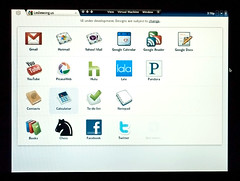 Image by lewong2000 via FlickrOkay. I gave you a link to a quick overview of what Chrome OS is and how and why it was developed. You can install the Chrome OS on a desktop machine, a notebook or a netbook computer. But the purpose of this blog is to talk about my experience with the Google CR-48 notebook since I was lucky enough to be selected for the Pilot Program and received a CR-48 to use an evaluate the Chrome OS as a platform.
Image by lewong2000 via FlickrOkay. I gave you a link to a quick overview of what Chrome OS is and how and why it was developed. You can install the Chrome OS on a desktop machine, a notebook or a netbook computer. But the purpose of this blog is to talk about my experience with the Google CR-48 notebook since I was lucky enough to be selected for the Pilot Program and received a CR-48 to use an evaluate the Chrome OS as a platform.So today a little about Chrome OS on the CR-48. Since the OS is very small, boot time is very short. From a completely powered down state to ready to use is a scant 14 seconds or less. The user interface, which is in essence the Chrome browser, is sleek and fast. Support for Flash is included and the OS handles almost all file types flawlessly. The browser-like interface is tab-oriented, and as you may have read in the Chrome OS comic, each tab is a separate process so that anything that happens in one tab is isolated from the rest of the interface. This is great for security and safety.
Since the basic premise of the Chrome OS is that everything should live in the cloud, it's important, actually necessary to have an internet connection when using the CR-48. WiFi is the preferred method, and Google has also arranged a 100MB/mo. contract for each CR-48 with Verizon Wireless. So you have no reason not to be connected so that you can use your notebook computer.
The interface has a wrench icon in the toolbar area which is used to do such things as open a new tab or a new window, or an incognito window (no history, cookies, etc., making you unknown. It's also the way the OS does the "guest" user login.), or editing functions like copy/cut/paste. You'll also find the tools entry where you manage extensions and browsing data, open the javascript console or the task manager. There are entries for history and download managers, and an options entry. The options entry is where you can configure some very basic settings for the OS, like home page, wireless and cellular connections, languages, timezones, users and more. There is just enough here to customize the interface to your liking, but not so much that it is cumbersome or confusing.
The user interface itself seems very snappy, using the latest version of WebKit and a highly optimized javascript engine, and pages draw quickly and accurately. A little further down the road, I'll provide some links to interesting speed tests and demonstrations that highlight the speed of the engine.
Once you get the CR-48 up and running and configured to your liking, it's time to add extensions and Web Apps to provide the functionalities that you are most likely to use. In upcoming articles I will journal my experiences with some of these extensions and web apps, explaining why I chose them, what I think of them, and whether or not they have made it into my list of currently installed apps/extensions.
Thanks for reading. Please leave comments if you see something you like or dislike, and share with your friends who may have a bad case of CR-48 envy.

No comments:
Post a Comment